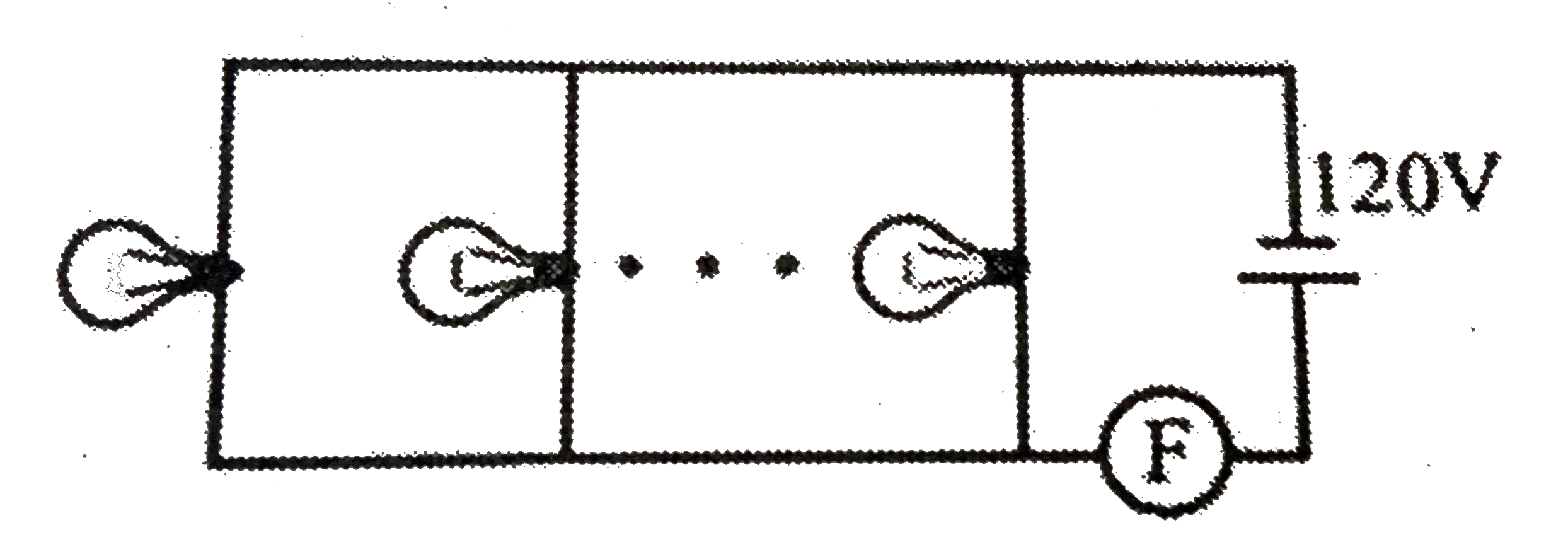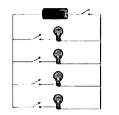A 15 amp circuit breaker trips in home when the current through it reaches 15 Amp. What is the minimum number of 100 watt light bulb operated at 120 volts in home that will cause it to the trip? Where N number of bulbs____
The correct Answer is:A
To solve the problem, we need to determine how many 100-watt light bulbs can be connected to a circuit before the 15 amp circuit breaker trips. Here’s a step-by-step breakdown of the solution:
Step 1: Understand the relationship between power, voltage, and current
We know that the power (P) consumed by an electrical device is given by the formula:
P=V×I
where:
- P is the power in watts (W),
- V is the voltage in volts (V),
- I is the current in amperes (A).
Step 2: Calculate the current drawn by one light bulb
Given that each light bulb has a power rating of 100 watts and operates at a voltage of 120 volts, we can rearrange the formula to find the current drawn by one bulb:
I=PV
Substituting the values:
I=100W120V
I=100120=56A
Step 3: Determine the total current for N bulbs
If N is the number of bulbs, the total current drawn by N bulbs can be expressed as:
Itotal=N×Ione bulb
Substituting the current for one bulb:
Itotal=N×56
Step 4: Set the total current equal to the circuit breaker limit
The circuit breaker trips at 15 A, so we set the total current equal to 15 A:
N×56=15
Step 5: Solve for N
To find N, we can rearrange the equation:
N=15×65
N=18
Conclusion
The minimum number of 100-watt light bulbs that can be operated at 120 volts before tripping the 15 amp circuit breaker is 18 bulbs.
---
We know that the power (P) consumed by an electrical device is given by the formula:
P=V×I
where:
- P is the power in watts (W),
- V is the voltage in volts (V),
- I is the current in amperes (A).
Given that each light bulb has a power rating of 100 watts and operates at a voltage of 120 volts, we can rearrange the formula to find the current drawn by one bulb:
I=PV
Substituting the values:
I=100W120V
I=100120=56A
If N is the number of bulbs, the total current drawn by N bulbs can be expressed as:
Itotal=N×Ione bulb
Substituting the current for one bulb:
Itotal=N×56
The circuit breaker trips at 15 A, so we set the total current equal to 15 A:
N×56=15
To find N, we can rearrange the equation:
N=15×65
N=18
The minimum number of 100-watt light bulbs that can be operated at 120 volts before tripping the 15 amp circuit breaker is 18 bulbs.
Similar Questions
Knowledge Check
- Question 1 - Select One
Some light bulbs are connected in paralles to 120 V source as shown in the figure .Each bulb dissipates as power of 60 W .The circuit has a fuse F that burns out when the current in the cicuit exceeds 9A .Determine the largest number of bulbs, which can be used in this circuit without burning out the fuse
 A9B18C25D34
A9B18C25D34 - Question 2 - Select One
Consider the four circuited shown in the figure, each consisting of a battry, a switch, a light bulb a resistor, and eutger a capacitory or an iductor. Assume the capacitor has a large capacitorand the inductor has a large inductance but no resitance. The light bulb has high efficiency. glowing whenever it carries electric current. (i) Describe what the light bulb does in each of each of curcuits (a) through (d) after the switch is thrown closed. (ii) Describe what the light bulb does in each of circuits (a) through (d) when, having been closed for a long time interval, the switch is opened.
A B
B C
C D
D
[" 120-V DC power line is protected by a "15" -A fuse.What is the maximum number of "],[120V,500W" purely resistive light bulbs that can be operated at full brightness from this line in parallel? "]
View SolutionThe given figure shows a simple circuit containing four bulbs and five switches along with a battery.

What is the minimum number of switches that must be closed to light at least one bulb?View Solution(a) When does a fuse cut off current ? How does it do it ?
(b) What is the maximum number of 60 W bulbs that can be run from the mains supply of 220 volts if you do not want to overload a 5 A fuse ?View SolutionMax reaches the bal, and walks in wondering why Professor Maze had asked for him. "Oh, hello there Max" the professor says when he sees Max. "I've got something for you, but I seem to have misplaced it, I'm going to need yout help finding it. "Professor Maze continued "I kept the gift in a high security room. In the room, there are 17 lockers in a row, each has a door that you find yout gift, you can keep it. Else, the door will close automatically, and the gift will move to an adjacent locker." Can he find his gift? If so, what are the minimum number of attempts required? Report your answer as the sum of digits of the minimum attempts (eg. if number of min. attempts is 15, answer 6 as 1+5=6). Answer 00 if he cannot find his gift.
View SolutionIf two buibs of 25 W and 100 W rated at 400 V are connected in series across a440 V supply, will both the bulb fuse? If not, then which one ?
(b) Two bulbs rated at 60 W and 100 W (220 V) are connected (i) in series and (ii) in parallel. Find the heat dissipated in the bulbs and also the total heat dissipatedin the circuit.
(c) A heater is designed to operate with a power of1000 watts in a 100 volt line. It is connected with an identical heater (B) in series and a100 V second heater (C) in parallel as shown. What should be the resistance of C so that the heater A may operate at a power level of 62.5 watts, if the entire combination is connected across a 100 V line
 View Solution
View SolutionAnswer question on the basis of your understanding of the following paragraph and the related studied concepts :
Bulk matter is made up of many molecules, which are so closely packed that the electrons are no longer attached to individual nuclei. In metallic conductors some of the electrons are practically free to move within the bulk material. Ordinarily, the electrons will be moving due to thermal motion during which they collide with the fixed ions. An electron colliding with an ion emerges with the same speed as before the collision. However, the direction of its velocity after the collision is completely random and there is no preferential direction for the velocities of the electrons. So number of electrons travelling in any direction will be equal to the number of electrons travelling in the opposite direction and there will be no net flow of electrons and hence no net current.
When an external electric field →E is applied across a piece of conductor, electrons will be accelerated at →a=e→Em . If →a was the velocity of electron after the last collision then velocity →vt after a time t will be →vt=→u+→at
The average velocity of the electrons at time t is the average of all→v' s. However, average value of →u's is zero. As collisions of the electrons occur at random times, let τ be the average time between successive collision and then the average velocity electrons is expressed as →vd (known as the drift velocity) and is given as:
→vd=−e→Emτ
This drift motion of electrons is responsible for establishment of an electric current in the conductor on applying an external electric field across it. The magnitude of current is given as : I=nAevd, where n= number density of free electrons and A = cross-section area of the conductor. It is to be noted here that drift speed is estimated to be of the order of 10−3ms−1 for currents in the range of a few amperes.
What is the rate of flow of electric field through the conductor ?View Solution

